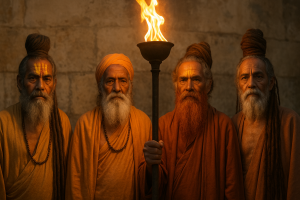Atal Akhara, one of the oldest and most respected Akharas in India, is a treasure house of spiritual heritage. Its strength lies not just in its structure or traditions but in the luminous lives of its historical saints, whose penance and teachings laid the very foundation of its dharmic identity.
These saints were not merely religious figures — they were visionaries, philosophers, warriors of righteousness, and torchbearers of Sanatan Dharma in turbulent times.
Origins Rooted in Tapasya
The origin of Atal Akhara is said to trace back to the teachings of Adi Shankaracharya, under whose vision the Dashanami Sampradaya was formally organized. The historical saints of Atal Akhara were among the early sannyasis initiated into this sacred lineage. They withdrew from worldly attachments to devote their lives to deep tapah (austerity), Vedantic study, and propagation of dharma.
Their dwellings were not palaces but forests, caves, and banks of sacred rivers, where they practiced severe penance and attained self-realization.
Guardians of Dharma
During times of political and religious upheaval, these saints played a crucial role as protectors of Vedic culture. They stood against forced conversions, cultural erosion, and defended the rights of the Sanatan tradition with courage. Not only spiritual teachers, some historical saints were also warrior-monks, skilled in shastra (scripture) and shastra (weapons).
Their lives taught that dharma is to be lived, protected, and passed on, not merely preached.
Great Names in Atal Akhara’s History
Though many saints chose to live in anonymity, some left behind legacies that are still honored:
- Swami Atalananad Ji – Believed to be one of the earliest saints whose name inspired the Akhara’s identity.
- Swami Dandeshwar Giri Ji – A revered figure known for reviving Vedantic studies during the medieval period.
- Swami Achyutanand Giri Ji – Known for his travels across India to spread Advaita Vedanta.
- Swami Rudranand Giri Ji – A master of yoga and tantra who guided thousands through inner transformation.
Their teachings, mostly preserved through oral tradition and disciple transmission, form the philosophical backbone of the Akhara.

Living Legacy
Even though centuries have passed, the impact of these saints remains alive in every mantra chanted, every sannyasi initiated, and every dharmic act carried out under the Akhara’s name. They remind us that spiritual power does not come from popularity, but from purity, penance, and purpose.
Modern saints and Mahamandaleshwars continue to walk the path laid by these great masters, ensuring that the river of wisdom flows uninterrupted.
Conclusion
The historical saints of Atal Akhara are not just names from the past — they are living legends in the soul of Bharat. Through their lives, we remember that Sanatan Dharma is eternal not because of its age, but because of the ageless spirit of those who lived it fully.


